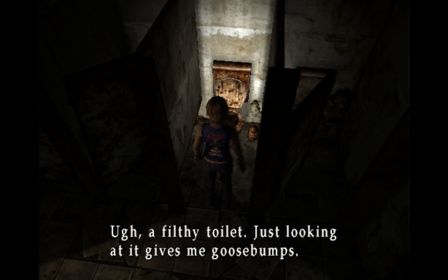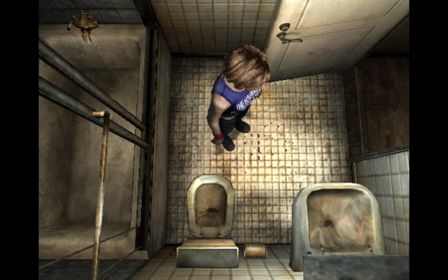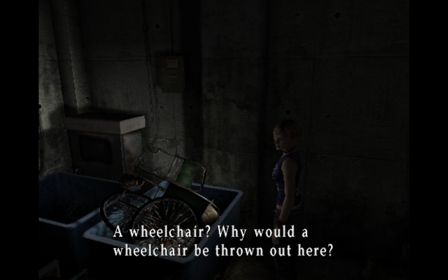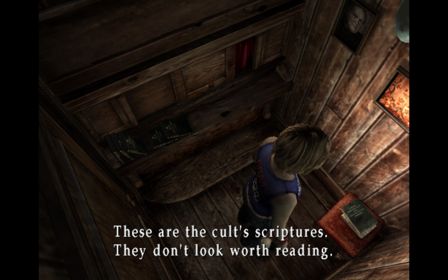Silent Hill 3 (2003)
‘Cause I’m just a girl…
I often wonder what collective trauma haunted Team Silent’s nightmares. Comparing the Silent Hill series to Resident Evil is like bloody apples to gory oranges. Not that Resident Evil is inferior, but they’re about traditional monsters over there, and more sci-fi than horror. The enemies are zombies, escaped chimeras, and mold people. As of RE8, we got bioweapon vampires and werewolves. In terms of ‘the monsters are us,’ the series delves into laissez-faire capitalism and enshittification.
But when Team Silent came along, the monsters became shambling aberrations, half-trapped in their own skin. Characters had their internal guilt manifest into the most disgusting demons since your colon softened its grip on year-old red beans and rice. The phrase here is psychological horror. It’s easy to shoot a zombie, harder to fight the demons in your own mind.
The first Silent Hill did a great job of subverting our expectations. At the end of the day, though, it was still about an ordinary man picking up a gun and shooting at monsters. But the series shifted direction as early as Silent Hill 2. Henceforth, the central idea was both a main character’s nightmare and a literature professor’s erotic fantasy, where the real monsters were THEMES. In Silent Hill 2, an ordinary man still shot at monsters, but they represented his repressed libido, midlife crisis, and “take my wife, please” frustration.
Two years later, out comes Silent Hill 3. Now, instead of an ordinary man shooting at monsters, an ordinary teenage girl picks up the gun. But the sequel doesn’t deviate at all in terms of thematic emphasis. Heather Mason’s game is a treatise on how much it sucks being a woman anywhere.
When it comes to Team Silent’s run on Silent Hill, there were no accidents. Any player assuming there’s a connotation isn’t reading too much into it. In Silent Hill 3, the entire summative metaphor is the plight of womanhood. Whether it’s the bloody “mirror room,” hallways made of suggestively pulsing flesh, or the phallic first boss, everything circles back to body horror or sex. Whatever the female protagonist would fear at her age is projected outward, personified into horror.
The allusions are everywhere. The game’s first half amounts to helping a girl walk home from the mall, with abominations slathering toward her on the subway. In the obligatory hospital section, Heather finds gifts and letters an unseen, creepy stalker left behind. But none of that compares to the main plot, concerning a dogmatic religious cult trying to force a teenage girl to give birth. The implications are obvious and difficult to misinterpret.
Unlike Silent Hill 2, 3 is a direct sequel to the first game. I don’t want to get too crazy with spoilers. But depending on what ending you got, protagonist Harry Mason may or may not have escaped Silent Hill with a baby he found. That baby was his daughter. Except not really, because she was his daughter reincarnated after fusing with her lost half and…it’s complicated. The key takeaway is Harry took the baby, ignoring the unspoken genre rule that she’d either become the kid from The Omen or face lots of problems.
Seventeen years later, the baby is now Heather Mason, formerly Cheryl, formerly Alessa. Heather is about to return home after an ordinary day that the mall, but there are unexpected complications. First, she runs into a grizzled detective the villains hired to find her.
Then the mall shifts from a welcoming 2003 shopping center to what it would look like in 2025. Suddenly it’s dark, foreboding, and disgusting. Most of the shutters are down, and the aesthetic is rusty and dilapidated, like it has suffered two decades’ worth of mold damage.
And there are monsters: lurching tall ones with punching bags for arms, and hell-hounds with Venus flytrap heads. Later, we see large, bloated, hideous things that look like Marshmallow Man made of terminal cancer. Later still, the demon nurses make a return, and they have fucking guns now.
Heather meets the woman behind the paranormal despair. With her long silver hair, deathly pale complexion, and British accent, Claudia comes off worse than a Victorian evangelical soccer mom. She talks about God an awful lot. From her, Heather learns that she is tied to a prophecy with the cult from the first game, something about Paradise being reborn after the world is unmade, and yes, God.
Now that Douglas the detective has uncovered Heather’s identity, the typical Silent Hill grossness nips at her heels. Heather must figure out how everyone and everything ties together, and what part the cult wants her to play in all the God business. The mystery will lead her to the titular Silent Hill, where the whole mess began in the first place.
But first, she has to live through it all. Silent Hill 3 is a survival horror game, with all the survival horror staples. Progressing through each area involves unlocking doors or figuring out which items serve whatever function. There’s also ammo and health items lying around, and the game strikes that balance between preserving bullets and risking damage. And damage is inevitable because enemies are all over the place. The smaller types are just as intimidating as the larger hulking ones, exercising strength through numbers as they crowd tight corridors.
Combat shows slight improvement over the previous games, but not much. Up to now, the series has been infamous for clunky-ass, rigid fighting that guaranteed losing health if you defended yourself. Heather can block and strafe, which is useful after the player masters those skills, or remembers they exist in the first place.
That’s because the best strategy is to run away. From everything. Most enemies have generous delays before their attack frames, providing the window to run, run, run. If you want to save bullets and keep your health high, pacifism is a guaranteed prevention method.
Like Harry and James before her, Heather is not a trained soldier or supercop. She is a teenager who could stand in for any high school kid waking up in Hell. Other than being the first playable female in the Silent Hill franchise, what sets her apart is her early 2000s, bad teenage attitude.
With that in mind, I am impressed with how the writing handles Heather. She isn’t a screaming, panicking victim, nor does she come off like a 48-year-old tried to write a child. A lot of games try way too hard to make their main character “strong” and “smart” with quippy Joss Whedon dialogue. Silent Hill 3 isn’t one of those games. Heather expresses a believable amount of fear at the beginning. But as we follow her story, she evolves until the inner cynic takes the scared girl’s place. Staring down the next bleeding hell monster no longer concerns her, as Heather hardens to being sick of everybody’s shit, and letting them know it.
And while Heather triumphs as a character, the supporting cast is just as powerful. The aforementioned Douglas isn’st nefarious at all, unless you put in the cheat code that strips him down to his underwear. He is as caught up in the mess, lied to and manipulated, as Heather. He and his voice actor channel a believable tormented and guilt-ridden old cop.
But by far the game’s real show stealer is Vincent, an untrustworthy, conniving troll who loves toying with people’s emotions to get reactions. Hilariously sinister, it’s clear he has his own agenda apart from Claudia. He is impossible to put faith in, but he is Heather’s only hope of getting anywhere.
In case it weren’t obvious, the Silent Hill 3 world is a creepy place. Aside from the dick monsters and rape metaphors, the game bleeds atmosphere—literally sometimes. At any moment there might be an out-of-place noise, put there to throw you off guard.
The atmosphere and character models also look very good for a PlayStation 2 game. In fact, Silent Hill 3 is a PS2 game with PS3-era visuals. I was surprised how good it looked twenty years ago, and it astounds me today. How did they make the game this pretty? What magic did they tap into? I compare it to games like Grand Theft Auto: San Andreas, guaranteed to print a bajillion dollars on release day, but so much uglier.
As pretty as Silent Hill 3 is, however, it’s also a bit on the short side. HowLongtoBeat estimates about six to eight hours worth of gameplay, and that is a good assumption. It only gets shorter the more one memorizes where to go. On the other hand, part of the fun of “classic” survival horror is how much faster these games can be beaten with each subsequent playthrough. Maybe it was more of an issue back then.
Here’s some more flesh to chew on, though. By the time you reach the titular Silent Hill, the game is a few sections away from being over. Silent Hill 3 features the least amount of Silent Hill until Silent Hill 4: The Room. Any opportunity to see the town is fleeting, as the one street you’re always allowed to run down is a linear conduit to the next area.
It’s clear all the money and development time was spent on the “help Heather get home” part and not the Silent Hill part. My running theory is they cut the most content from the town. In a situation where they could’ve spent resources on one or the other, but not both, which would’ve been better?
Returning to the game’s central theme, Silent Hill 3 is about every woman’s nightmare. Though the concept runs in the background at any given moment, the approach is subtle enough that it doesn’t climb onto a soapbox. Heather never turns to the camera, raises an eyebrow, and says, “Boy, men make it hard for me to live.”
Still, I suspect this sort of thing would be more difficult to present now. Called ‘woke,’ bending-the-something-or-other, review bombed on Steam. Subtext, especially progressive subtext, has been a thing for decades; I miss when people didn’t bitch so much about it. I also miss games like Silent Hill 3 being this good.
Final Rating: *** ½




